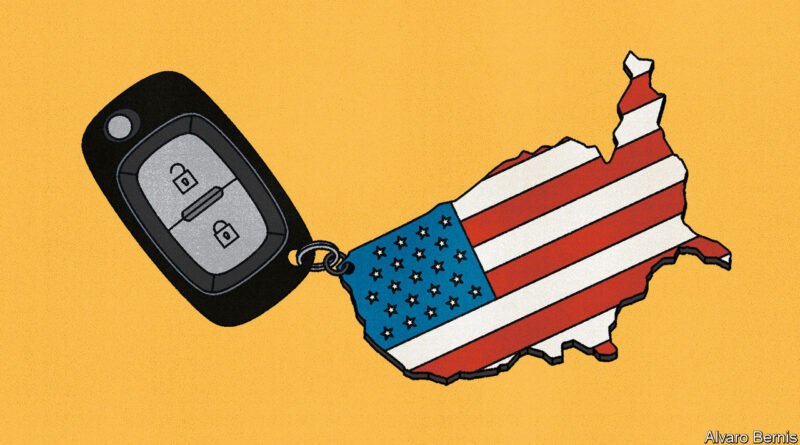In praise of America’s car addiction
No tradition is sacred—not even trick-or-treating. In recent Halloween festivities, many Americans switched to trunk-or-treating. Instead of going door-to-door on neighbourhood streets, children shuffled between cars in parking lots and collected candy from their open boots, which were bedecked by giant spiders and terrible ghouls. It was the latest demonstration of something that has long been true: cars have a remarkably tight grip on American life. America is far more car-reliant than any other big country, averaging roughly two vehicles per household. This, in turn, is linked to many ills: obesity, pollution, suburban sprawl and so on.
Despite such horrors, more Americans than ever are consigning themselves to a car-defined existence by choosing to live in the suburbs. Census figures reveal that after decades of steady growth, a little more than half the American population is now based in the ‘burbs. It seems a classic case of elite opinions (cars and suburbs are awful) diverging from mass preferences (people quite enjoy them). For many, the main attractions of suburbia are lower housing costs and greater safety. Yet recent research sheds light on how cars are a crucial part of the equation, making America’s suburbs both impressively efficient and equitable.
Start with convenience. It is well-known that American cities are configured for vehicles, a process that began in the 1920s with the Model T. Car-centric urban designs became dominant throughout the country, involving wide roads, ample access to expressways and parking galore. To varying degrees, other countries have copied that model. Yet America has come closest to perfecting it. In a paper released in August, supported by the World Bank, a group of economists examined road speeds in 152 countries. Unsurprisingly, wealthy countries outpace poor ones. And within the rich world, America is streets ahead: its traffic is about 27% faster than that of other members of the oecd club of mostly rich countries. Of the 20 fastest cities in the world, 19 are in America.
It is not that American roads are better in and of themselves. Rather, speed is a testament to America’s love affair with both suburbia and smaller towns that feel suburban. Compared with those in other oecd countries, American cities are 24% less populous, cover 72% more area and have 67% more large roads. All this enables drivers to zip around. New York, the country’s densest city, is an outlier, as anyone who has sat in its gridlock knows. But most of American suburbia more closely resembles Wichita, Kansas, and Greensboro, North Carolina, where drivers rarely face jams.
Driving speed shrinks distance. One fashionable concept among urban planners these days is the “15-minute city”, the goal of building neighbourhoods that let people get to work, school and recreation within 15 minutes by foot or bike. Many Americans may simply fail to see the need for this innovation, for they already live in 15-minute cities, so long, that is, as they get around by car. Most of the essentials—groceries, school, restaurants, parks, doctors and more—are a quick drive away for suburbanites.
The car’s ubiquity has another rarely appreciated benefit. A recent study by Lucas Conwell of Yale University and colleagues examined urban regions in America and Europe. They calculated “accessibility zones”, defined as the area from which city centres can be readily reached. Although European cities have better public transport, American cities are on the whole more accessible. Consider the size of accessibility zones 15-30 minutes from city centres. If using public transport, the average is 34 square kilometres in America versus 63 square kilometres in Europe. If using private cars, the difference is much starker: 1,160 square kilometres in America versus 430 square kilometres in Europe.
Just as it is easier to get into American city centres, so it is easier to get out of them. Over time that has sapped vibrancy from their downtown cores as people flee offices at the end of the day for far-flung homes. However, there is a more positive way of looking at this phenomenon: it is precisely such accessibility that has put larger homes and quieter streets within reach for a remarkably wide cross-section of the country. In his analysis of the census from 2020, William Frey of the Brookings Institution, a think-tank, showed that suburbia has become far more diverse over the years. In 1990 roughly 20% of suburbanites were non-white. That rose to 30% in 2000 and 45% in 2020.
Not that cars are a panacea. Owning or renting one costs plenty of money, and is an especially big burden for the working poor. It is therefore common to hear laments in American cities about the sorry state of mass transit. Yet this general perception, though widespread, is not entirely accurate. Even if primarily built for private cars, roads are a shared resource and can be viewed as the “tracks” for buses. In their study Mr Conwell and his colleagues conclude that bus-based transportation in America is surprisingly effective: public-transit options between distant suburbia and city centres are roughly comparable in America and Europe. Although America could do more to improve its bus services within its urban cores, the crucial point is that cities designed for cars can also support mass transit.
Honk for motors
Today some things are in flux. Younger Americans are driving less. More cities are building walkable neighbourhoods. New York may soon introduce congestion charging. It is, in short, possible to imagine an America that is less addicted to cars.
At the same time, though, covid-19 has changed lifestyles in ways that may favour vehicles. People are venturing into offices less often. That has reduced demand and revenues for public transit while making roads less congested and thus more pleasant for drivers. If the rise of remote work enables families to drift ever deeper into suburbia, cars will become more indispensable. How will it all shake out? Given how ingrained cars are in American life, trunk-or-treating is probably here to stay. ■
Read more from Free exchange, our column on economics:
The Middle East’s economy is caught in the crossfire (Nov 2nd)
Israel’s war economy is working—for the time being (Oct 26th)
Do Amazon and Google lock out competition? (Oct 19th)
For more expert analysis of the biggest stories in economics, finance and markets, sign up to Money Talks, our weekly subscriber-only newsletter



